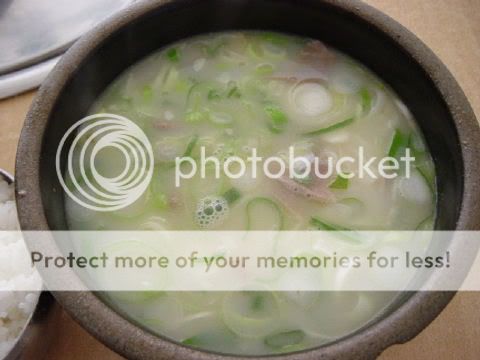
Pretty standard set up interior wise.

Here, the kimchi is served in the mini clay urns. You have the radish kimchi (bottom) and chinese cabbage kimchi (top). These are cold kimchis straight from the refridgerator. Grab as much as you like and cut it into desired size and place on plate.
I like the chinese cabbage kimchi but I'm not a big fan of the radish kimchi.

This is the seolleong tang. KRW5,000. This clear soup is made by boiling beef and bones for at least 16 to 18 hours, and served with sliced beef and garnished with sliced scallion and leek.
The hallmark of a good seolleong tang, I'm told, is that the huge iron pot (gamasot) used to simmer the broth is left running 24x7 - it never shuts down.

Typically, the seolleong tang comes unseasoned (unsalted and unpeppered). You will usually find salt and black pepper in the condiment tray on your table. Add to taste and stir well.

Some places serve the seolleong tang without the (wheat flour) noodles. Here they come with it. The noodles are soft and silky smooth. Slurp.

Add in the bowl of rice and enjoy. Some folks add kimchi to the soup. It's all a matter of personal preference. I like mine original and clear.
The soup has a nice beefy overtone, but without being overpowering. I'm also glad that there's hardly any traces of excessive fat floating on the surface of the soup. They've done a good job at skimming the residual scum away. Adding a good pinch of salt and black pepper to the soup is essential to bring out the flavours. A good choice if you're really not into spicy soups or stews.